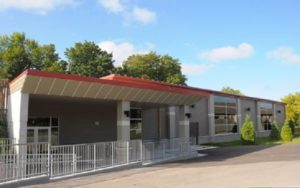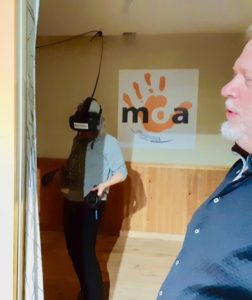A visit with Dr. Neal Ferris at Sustainable Archaeology

By Laurie Leclair
In 1975, the province of Ontario passed the Ontario Heritage Act designed to give municipal and provincial governments the power to protect both heritage properties and archaeological sites. Following its passing, it became law that new land development projects were subjected to a heritage assessment. To fill the demand brought on by the legislation, the province saw a new wave of Cultural Resource Management (CRMs) companies. Often working for private concerns, these CRMs employ licensed archaeologists to determine whether lands slated for development are archaeologically significant. Given the increase in construction, CRM-driven projects now make up as much as 90% of all the archaeological investigations in the province.
In part because of time and budget restrictions, the artifacts collected at these investigations may receive very little analysis and what they do receive remains specific to the site and the limited requirements outlined in the Heritage Act. Once the Act’s conditions are met, the materials are stored away. This process has continued for decades and has led to a large amassing of artifacts, their boxes often kept in disparate and potentially degraded conditions.
The historiography, methodology and purpose of archaeology have changed dramatically since the implementation of the Heritage Act. There is a need to bring existing laws in step with this evolution and First Nations are becoming increasingly proactive over heritage management. This includes a stronger voice in determining what it means to subject artifacts to “long-term care”, as well as more philosophical arguments over the purpose of archaeology itself. For some, the interpretation, questioning and reinterpretation of the past are part of the important process of decolonization.
Dr. Neal Ferris, Lawson Chair of Canadian Archaeology, Western University and Museum of Ontario Archaeology, sees a collaborative relationship between archaeologists and Indigenous groups as both “right and inevitable,” given the Crown’s fiduciary responsibilities to First Nations, including its duty to consult. This reasoning became an important motivation behind the creation of Sustainable Archaeology (SA), a research institution partly funded by and connected to the Museum of Ontario Archaeology in London, Ontario. Its mandate is twofold: to conduct comparative studies of those assemblages coming from the wealth of digs spurred on by commercial developments, and to use these studies to help Elders and heritage keepers and scientists gain a more profound and updated history of those who came before us. SA also focusses on reviewing the needs and issues surrounding the care of the province’s ancient material record.

In March, Anishinabek Nation’s Government Relations Coordinator Kevin Restoule together with researcher Laurie Leclair visited Ferris, a former director of SA and now its Advisory Committee’s facilitator. After a tour of part of the 18,000 square foot storage space, visitors were guided through SA’s research laboratory. The available technology is impressive: SA boasts a micro-CT and 3D scanners, flotation and digital x-ray machines, and a Virtual Reality Ancestral Longhouse. However, with this technology comes important responsibilities. The need for the advice of First Nations and Indigenous groups is obvious and understood by SA, as once you have the capabilities of digitization and replication you have to question the appropriateness of its application. Questions of this sort require a certain sensibility, both for the lives of those who lived in the past, and the concerns of Indigenous groups and First Nations. Here, SA has developed methodologies not only for the physical “long-term care” of collections in the sense of correct storage and security but also to work out curatorial strategies that honour the cultural values of what Ferris calls the Descendant People. This includes rethinking how we describe and order collections and the terminology we use, including the development and inclusion of Indigenous language glossaries.
An Advisory Committee (AC) comprised of archaeologists and members from First Nations deliberates on these and more mundane issues. Ferris likens it to a “discussion circle” where topics can remain open from one meeting to the next. Decisions are made through dual consensus, where each side must agree in order for a resolution to move forward. Co-management and parity are key to the committee’s function. Currently, there are 12 members, six from the archaeological field and six from several Indigenous communities and First Nations, including Kettle and Stony Point First Nation. The Committee also helps draft working agreements and Memorandums of Understanding between SA and those First Nations who seek interim storage solutions for archaeological collections. One of the long-term goals of the committee is to see the jurisdiction of these types of agreements expanded to include the traditional territories of participating communities.
This Committee also deals with the challenging subject of the repatriation of ancestors and sacred items through the creation of its “Respect through Practice” policy. Rather than refuse to accept human remains at the facility, the Committee decided that it would be best when confronted with the situation, to receive them, to “make sure proper outcomes and respect occurred, rather than risk the collection being lost and ancestors not treated with respect.” Ferris explains that this policy ensures that human remains and sacred items are immediately identified, communities are notified as soon as the identification is made, and it will be that community who will direct the manner of interim care, the method of repatriation and any other concerns which would surface. Presently, the Advisory Committee is in the process of drafting a new policy for the proper treatment of Human Remains and Sacred Items.
The Museum of Ontario Archaeology is located at:
1600 Attawandaron Rd.
London, Ontario
N6G 3M6.
Due to the recent coronavirus disease 2019 (COVID-19) pandemic, it remains closed until further notice. For more information, visit: http://archaeologymuseum.ca/visit-us/hours_admission/


